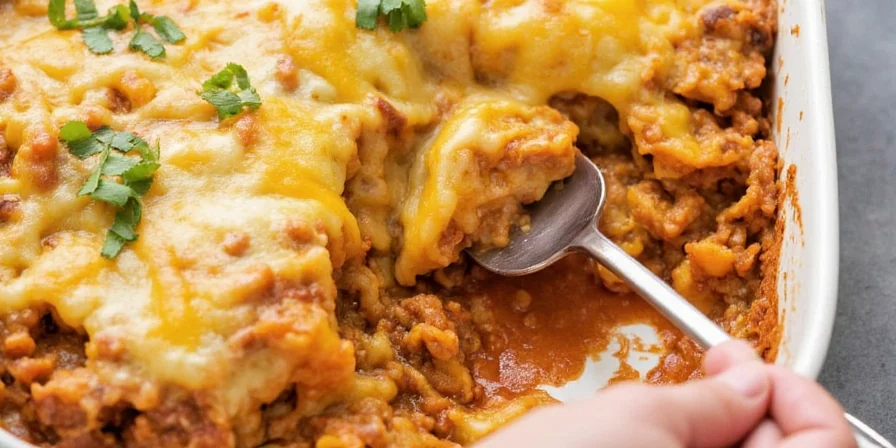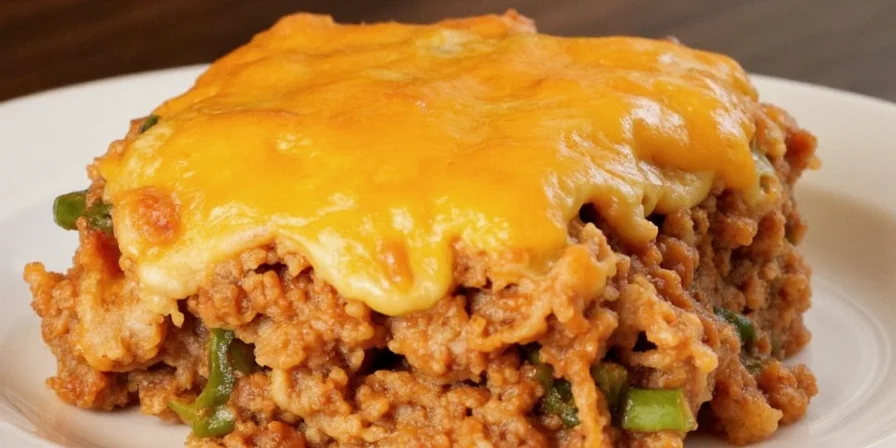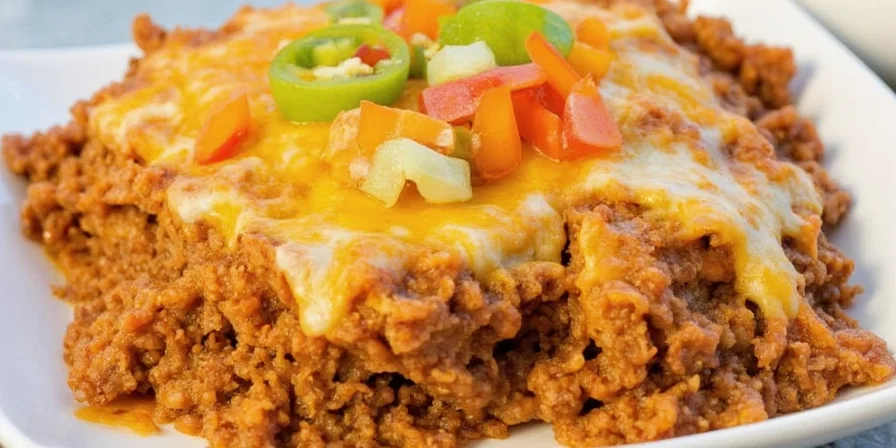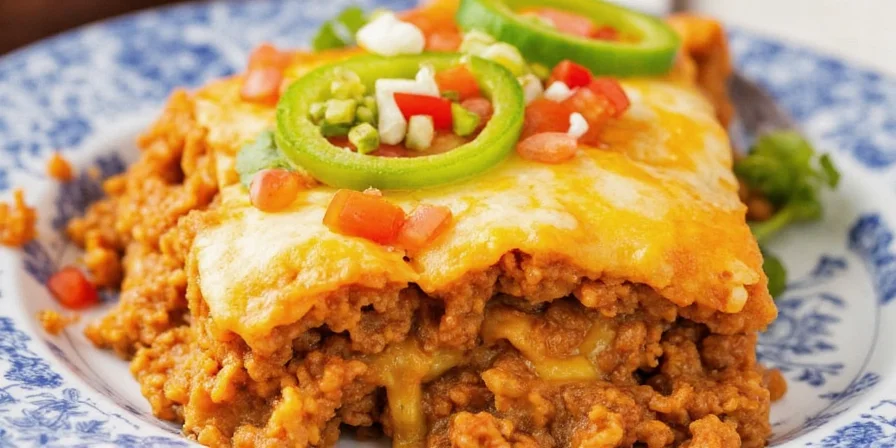For home cooks seeking restaurant-quality results without complexity, this guide unlocks bold new flavors in taco enchilada casserole. Tired of predictable weeknight meals? Discover how innovative spice pairings transform this comforting classic from ordinary to extraordinary—using pantry staples you already own. Let's explore scientifically backed flavor combinations that create depth without demanding chef-level skills.
Table of Contents
- What Exactly Is a Taco Enchilada Casserole?
- The Science (and Art) of Spice Pairing
- Top 5 Innovative Spice Pairings for Your Casserole
- Pro Tips to Level Up Your Spicy Game
- Visual Spice Comparison Table
- Final Thoughts: Go Forth and Season Boldly
- Frequently Asked Questions
What Exactly Is a Taco Enchilada Casserole?
This dish merges the handheld joy of tacos with the baked comfort of enchiladas. Layers of seasoned protein, corn tortillas, enchilada sauce, beans, and cheese bake into a cohesive masterpiece. But here's the revelation: its flavor ceiling isn't set by ingredients—it's determined by how you combine spices. We've moved beyond generic "taco seasoning" to target specific flavor dimensions.

Unlike traditional recipes, our approach focuses on intentional layering—each component receives tailored seasoning. This transforms the casserole from a single-note meal into a dynamic flavor journey where every bite reveals new complexity.
The Science (and Art) of Spice Pairing
Effective pairing isn't random experimentation. It leverages three principles home cooks can master:
Why Do Some Spices Work Together?
- Volatile Compound Synergy: Spices sharing molecular structures (like cumin and sumac both containing pinene) create seamless flavor bridges.
- Cultural Cross-Pollination: Historical trade routes prove certain combinations transcend geography—think Middle Eastern sumac meeting Mexican cumin.
- Thermal Activation: Toasting spices releases oils that interact with dairy and proteins, unlocking layered notes impossible in raw blends.

Unique Perspective: Flavor Geometry
Move beyond linear "heat measurement." Visualize flavors as three-dimensional shapes: earthy spices (cumin) form broad bases, citrus notes (sumac) add sharp peaks, and sweet elements (cocoa) create smooth transitions. Our pairings construct intentional flavor topography where each element has spatial purpose.
Top 5 Innovative Spice Pairings for Your Casserole
These combinations solve specific flavor gaps in traditional recipes. Each targets one dimension while preserving cultural authenticity:
-
Cumin + Sumac
Problem Solved: Overly heavy meat sauces. Sumac's citrus lift cuts richness without watering down flavors. Use 1 tsp sumac per tbsp cumin in bean layers.
-
Chili Powder + Allspice
Problem Solved: One-dimensional heat. Allspice's berry notes (from Jamaica's pimento berries) add fruitiness that mimics slow-cooked depth in 30 minutes.
-
Paprika + Ground Coriander
Problem Solved: Bland tomato bases. Coriander's lemony front note followed by paprika's smoky finish creates flavor movement.
-
Ancho Chile Powder + Cocoa Powder
Problem Solved: Sweetness imbalance. Ancho's raisin-like fruitiness meets cocoa's bitterness—no sugar needed. Ratio: 2:1 ancho to cocoa.
-
Lime Zest + Cayenne Pepper
Problem Solved: Heat fatigue. Zest's volatile oils release first, carrying cayenne's burn in a controlled wave. Always add zest raw.

Pro Tips to Level Up Your Spicy Game
Transform theory into practice with these precision techniques:
- Thermal Sequencing: Toast whole cumin seeds first, then add ground coriander 30 seconds later—different compounds release at different temperatures.
- Acid Layering: Add 1 tbsp vinegar to meat while browning; finish with fresh lime juice. This creates acid depth without sourness.
- Texture Mapping: Mix coarse sumac with fine cumin—larger particles settle differently, creating flavor pockets.
- Cheese Integration: Stir spices into melted cheese before topping. Fat-soluble compounds distribute more evenly.
- Resting Protocol: 15-minute rest isn't optional—it lets starches set and volatile compounds redistribute.

Visual Spice Comparison Table
| Spice Pairing | Flavor Profile | Best Used In | Pair With |
|---|---|---|---|
| Cumin + Sumac | Earthy base with citrus peak | Bean layers, meat seasoning | Greek yogurt drizzle |
| Chili Powder + Allspice | Smoky foundation with berry notes | Ground protein seasoning | Pepper jack cheese |
| Paprika + Coriander | Smooth smokiness with lemon lift | Sauce integration | Avocado crema |
| Ancho Chile + Cocoa | Fruity heat with bitter chocolate finish | Enchilada sauce base | Queso fresco |
| Lime Zest + Cayenne | Bright citrus peak with delayed heat | Finishing garnish | Pico de gallo |

Final Thoughts: Go Forth and Season Boldly
Mastering these pairings turns you from recipe follower to flavor architect. The true innovation isn't in exotic ingredients—it's in understanding how common spices interact. Start with one pairing this week; notice how sumac transforms your bean layer or how allspice deepens chili powder's profile. Remember: precision beats quantity. A 1/4 tsp adjustment creates more impact than doubling everything.
Don't chase complexity—seek intentionality. Your casserole will reflect not just what you cook, but how thoughtfully you combine elements. Now go create flavors that tell a story.

Frequently Asked Questions
Can I use these pairings in traditional tacos or enchiladas?
Absolutely. Apply the same principles: sumac in taco meat prevents heaviness, while ancho-cocoa works in enchilada sauce. Adjust quantities by 25% since casserole concentrates flavors during baking.
How do I fix an over-spiced casserole?
Dilute heat with dairy (sour cream) or acid (lime juice)—never water. For earthy overtones, add a pinch of sugar. If spices were toasted too long, stir in fresh herbs like cilantro to reset the palate.
Are these spices safe for meal prep?
Yes, but store layered components separately. Toasted spice oils degrade fastest in dairy—add cheese toppings fresh. Pre-mixed dry spices keep potency for 2 weeks in dark glass jars.
Why does lime zest work better than juice for heat control?
Zest contains concentrated volatile oils that interact with capsaicin receptors before heat registers, creating a perceived cooling effect. Juice's water content dilutes flavors without modulating heat perception.











 浙公网安备
33010002000092号
浙公网安备
33010002000092号 浙B2-20120091-4
浙B2-20120091-4